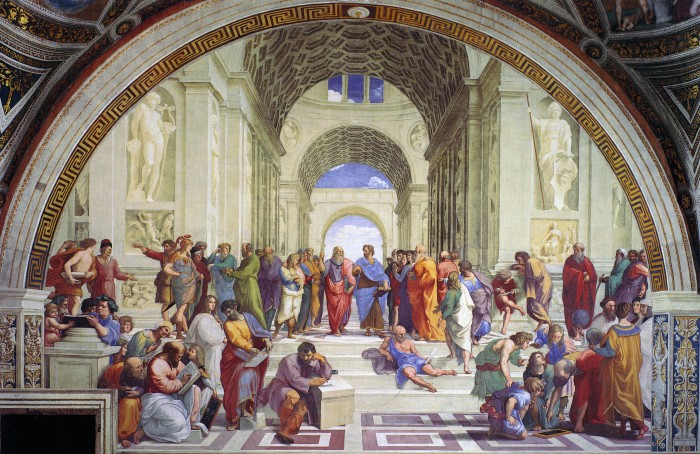Raphael, 1483-1520
Raphael, The School of Athens, 1509-11. St Andrews Image Database. https://imagedatabase.st-andrews.ac.uk/images/viewimage.php?id=GZxLhuSeohc=
By Lori Stranger
The painter and architect Raphael was born on 6th April, 1483, in Urbino, and died on 6th April 6th, 1520, in Rome. He was an important figure of the High Renaissance and has greatly affected generations of artists to this day.
The importance of Urbino as the basis of Raphael’s early life cannot be underestimated. Urbino was an important artistic centre whose court had employed crucial Renaissance artists such as Pierro della Francesca, and Leon Battista Alberti. Raphael’s father Giovanni Santi, who was a painter for Duke Federico da Montefeltro, exposed Raphael to the principles of humanism, which dominated the court and would come to influence his later style very heavily.
After his father’s death in 1494, Raphael began his apprenticeship with the master painter Perugino, in Perugia. Raphael was greatly influenced by Perugino’s calm, serene style of painting. This is evident through when Perugino’s The Giving of the Keys to St Peter, 1481-82, is compared to Raphael’s The Marriage of the Virgin, 1504. The use of linear perspective and symmetrical composition demonstrate the influence Perugino had over Raphael’s style and work. However, Raphael’s differed from his master in his emphasis on psychological depth.
In 1504, Raphael moved to Florence, where he was exposed to the works of Leonardo da Vinci, Michelangelo and Fra Bartolommeo, who inspired Raphael to pursue a more expressive naturalism and giving greater depth to his paintings.
The influence of Leonardo and Michelangelo is most evident in his series of Madonna paintings. For example, Leonardo’s The Virgin and Child with St Anne, 1503, demonstrated an intimacy and complex sfumato modeling, which Raphael adopted in his Madonna of the Goldfinch, 1505, and Madonna and Child with Saint John the Baptist, 1507. However, Raphael’s paintings retained the calm and serene quality of his earlier works, in comparison to the dramatic intensity of Leonardo and Michelangelo.
The year 1508 marked a crucial transition in Raphael’s life. He was called to Rome by Pope Julius II, a great patron of the arts, and between 1508-11 Raphael was tasked to paint a series of frescos for the Vatican papal apartments of the Stanza della Segnatura room. The larger walls of the Signature depict the frescos Disputa and School of Athens, expressing the humanistic philosophy that Raphael had learnt in the Urbino court of his childhood. The School of Athens fresco, arguably Raphael’s most famous work, presents an allegory of secular knowledge and philosophy, depicting Plato and Aristotle surrounded by various philosophers in a classical architectural setting. The painting firmly demonstrates Raphael’s High Renaissance style. The stable, symmetrical composition and classical architectural order contributes to a realistic spatial recession, which presents an idealised setting that celebrates all human knowledge.
The last years of Raphael’s life illustrated a maturation of his style. Raphael’s last work, The Transfiguration, 1516-20, demonstrates the culmination of his career in the intense psychological gestures and bolder, dynamic composition, which perhaps precipitates the Mannerist movement, which would succeed the High Renaissance.
He was buried in the Pantheon in Rome, marking the high regard that he was held in by his contemporaries. The epitaph for his tomb was composed by the leading scholar Cardinal Bembo, and it reads ‘here lies that famous Raphael, by whom Nature feared to be conquered while he lived, and when he was dying, feared herself to die.’
Bibliography
“Raphael Biography”, Biography.com. Accessed 1st April 2018. https://www.biography.com/people/raphael-41051
Finnan, Vincent, “Raphael”, ItalianRenaissanceArt.com. Accessed 1st April 2018. https://www.italian-renaissance-art.com/Raphael.html

